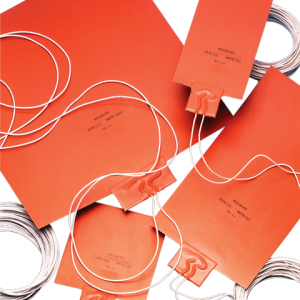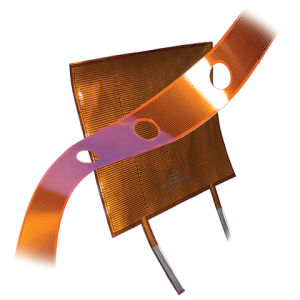-
SILICONE RUBBER HEATERS
IMPROVE HEAT TRANSFER, SPEED WARM UPS AND DECREASE WATTAGE REQUIREMENTS
Watlow silicone rubber heaters are rugged, yet thin, lightweight and flexible. Use of these heaters is limited only by the imagination. Heat can be put where it is needed. These silicone heaters improve heat transfer, speed warm ups, and decrease wattage requirements.
Fiberglass-reinforced silicone rubber gives the heater dimensional stability without sacrificing flexibility. Because very little material separates the element from the part, heat transfer is rapid and efficient. The silicone rubber heaters are constructed with a wire-wound element or an etched foil element. The heater construction creates a very thin heater allowing it to fit applications where space is limited.
- Designed to the exact shape and size needed which conforms to the component and/or equipment
- More than 80 designs available immediately from stock reduces downtime
- Constructed with wire-wound or etched foil elements provides the desired flexibility for many dynamic applications and delivers low mass and easily repeatable distributed watt densities
- Moisture and chemical-resistant silicone rubber material provides longer heater life
- Vulcanizing adhesives or fasteners allows heaters to be easily bonded to parts
-
PUMP AND GAS LINE HEATING SYSTEMS
INCREASE TOOL UPTIME AND PROCESS YIELDS
Watlow’s gas line heaters are designed to regulate temperatures in gas lines in order to prevent condensation in the gas line.
Tetraethyl orthosilicate (TEOS), boron trichloride (BCl3), aluminum chloride (AlCl3), chlorine trifluoride (ClF3) and dichlorosilane (DCS) are gases that condense or liquefy due to a phase shift at low temperatures. In semiconductor processes, the condensation occurs in the gas line and puddles in the shower head before being injected into the vacuum chamber. A substantial number of wafer defects will occur if liquefied gases are injected into the vacuum chamber. Uniform heating of the lines with gas line heaters will prevent condensation. TEOS lines are typically heated above 194°F (90°C) and BCl3 above 86°F (30°C), depending on pressure and flow rate. The optimum line temperature will vary depending on the process parameters.
- Easy to install two part system which conveniently fits on most gas line configurations
- Flexible heater design gives engineers the flexibility to easily customize the thermal profile for each gas line application and allows quick prototyping to determine energy distribution requirements for process improvement
- Flexible standard system components eliminates unnecessary lead times for custom designs
-
POLYIMIDE HEATERS
POLYIMIDE MATERIAL OFFERS STRENGTH, TEAR RESISTANCE AND STABILITY
Polyimide is a thin, lightweight organic polymer film which provides excellent tensile strength, tear resistance and dimensional stability. This heater is ideal for applications requiring low outgassing in a vacuum, or resistance to
radiation, fungus and chemicals. Polyimide is also solvent resistant.- Excellent physical and electrical properties results in thermal stability over a wide temperature range
- Transparent polyimide material allows inspection of internal details
- Resistance of radiation and fungus allows it to be used in a wide range of applications
Material Maximum Operating TemperaturesMaximum Watt DensitiesPolyimide 392F° 200C° 50W/in2 7.75W/cm2 Read More > Flexible Heaters pdf






